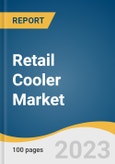The global retail cooler market size is expected to reach USD 2.79 billion by 2030, expanding at a CAGR of 8.7% from 2023 to 2030. An increase in the number of outdoor activities including camping and hiking is positively impacting the growth of the market. For instance, according to the Sport Consumer Survey conducted by the European Outdoor Group, in 2021, sports activities including hiking were the most prominent activities in Europe in which consumers majorly participated.
Rising demand for packaged food and beverages, along with the rapid expansion of the hospitality sector, has led to substantial market growth. The ongoing expansion of consumer goods retail chains across the globe is also likely to drive the market further. In addition, better technologies used for manufacturing lightweight chillers that can retain ice for a longer duration will contribute to market growth over the coming years.
In terms of value, coolers with a capacity of above 50 quarts dominated the market in 2021 and are expected to maintain their lead over the forecast period. These large-capacity retail coolers are perfect for long road trips, days spent at campsites, and sporting events. Additionally, the product is often equipped with heavy-duty wheels to roll the cooler through tough terrain with the rigged wheels while it’s fully loaded.
North America held the largest revenue share in 2021 owing to the rise in the inclination of people in North America toward outdoor recreational activities, short trips, and picnics. For instance, according to the North America Camping Report by KOA, in 2021, around 57 million households reported going on at least one camping trip, depicting an increase of 18% compared to 2020.
Companies in the market are focusing on strategies such as mergers and acquisitions in order to gain market share and increase their service footprint. In July 2019, Huntington Solutions acquired Texas Foam, a manufacturer of customized extended-duration shippers (XDS™) and temperature-sensitive protective foam packaging solutions. This acquisition enabled the company to increase and broaden its production capabilities and bolster its cold chain offerings.
Rising demand for packaged food and beverages, along with the rapid expansion of the hospitality sector, has led to substantial market growth. The ongoing expansion of consumer goods retail chains across the globe is also likely to drive the market further. In addition, better technologies used for manufacturing lightweight chillers that can retain ice for a longer duration will contribute to market growth over the coming years.
In terms of value, coolers with a capacity of above 50 quarts dominated the market in 2021 and are expected to maintain their lead over the forecast period. These large-capacity retail coolers are perfect for long road trips, days spent at campsites, and sporting events. Additionally, the product is often equipped with heavy-duty wheels to roll the cooler through tough terrain with the rigged wheels while it’s fully loaded.
North America held the largest revenue share in 2021 owing to the rise in the inclination of people in North America toward outdoor recreational activities, short trips, and picnics. For instance, according to the North America Camping Report by KOA, in 2021, around 57 million households reported going on at least one camping trip, depicting an increase of 18% compared to 2020.
Companies in the market are focusing on strategies such as mergers and acquisitions in order to gain market share and increase their service footprint. In July 2019, Huntington Solutions acquired Texas Foam, a manufacturer of customized extended-duration shippers (XDS™) and temperature-sensitive protective foam packaging solutions. This acquisition enabled the company to increase and broaden its production capabilities and bolster its cold chain offerings.
Retail Cooler Market Report Highlights
- The above 50 quarts capacity segment dominated the market with a revenue share of over 54.0% in 2022. Retailer coolers with large capacity are used for storing all food and drinks for two or more than two people, which favors the growth of the market
- The online distribution channel segment is expected to register the highest CAGR of 9.8% from 2023 to 2030. Increasing internet penetration among the middle-class population, coupled with the rising use of smartphones and similar devices, is the key factor driving the popularity of online channels in the market
- Asia Pacific is expected to register the highest CAGR of 9.8% over the forecast period. The growth in the region is majorly attributed to an increase in the number of outdoor activities such as camping among consumers
Table of Contents
Chapter 1. Methodology and Scope
Chapter 2. Executive Summary
Chapter 3. Retail Cooler Market Variables, Trends & Scope
Chapter 4. Consumer Behavior Analysis
Chapter 5. Retail Cooler Market: Capacity Estimates & Trend Analysis
Chapter 6. Retail Cooler Market: Distribution Channel Estimates & Trend Analysis
Chapter 7. Retail Cooler Market: Regional Estimates & Trend Analysis
Chapter 8. Competitive Analysis
List of Tables
List of Figures
Companies Mentioned
- Polar Bear Coolers
- Lifoam Industries LLC
- ORCA Coolers, LLC
- Plastilite Corporation
- ICEE Containers Pty Ltd.
- Bison Coolers
- Grizzly Coolers LLC
- Huntington Solutions
- The Coleman Company, Inc.
- YETI Holdings, Inc.
Methodology

LOADING...
Table Information
| Report Attribute | Details |
|---|---|
| No. of Pages | 100 |
| Published | August 2023 |
| Forecast Period | 2022 - 2030 |
| Estimated Market Value ( USD | $ 1.43 Billion |
| Forecasted Market Value ( USD | $ 2.79 Billion |
| Compound Annual Growth Rate | 8.7% |
| Regions Covered | Global |
| No. of Companies Mentioned | 10 |









